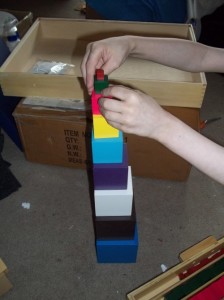Continent
Folders? You're thinking, "You mean Continent
Boxes, right?"
Nope. I mean Continent
Folders.
They actually also go by "Montessori cultural folders" as well. Either name is accurate and neither name fully describes them!
 |
These were originally going to be our Montessori Continent Boxes.
Now they are toy boxes. |
I like the idea of the continent boxes (cultural boxes) - and I had even bought a set of stackable drawers to use for just such purpose, before I went to AMI Primary Montessori training. We could still use them as continent/cultural boxes, but I never really found the need for them
in my household. Instead I re-purposed them to hold Legoboy's small toys: small animals, train tracks, cars, small scenery pieces, etc. He still uses them, but now has them reorganized according to his own (internalized, elementary-level, crazy-from-the-outside) organization.
Ultimately, I went with what I received in Montessori training. Folders. The continent/cultural folders spark discussion, they promote interest... and then we can pull out the objects we have
around the environment which the child is
surrounded by for further discussion and experiences: books in the reading area, artifacts used as decoration around the environment (also used for polishing, dusting, flower-arranging, etc.), games to play with friends and family, etc. The objects and experiences are
throughout life, rather than kept together in one box. The child is surrounded by cultural objects rather than having them boxed up. The child can go into the environment and gather appropriate objects for this study.
LATER UPDATE (just this paragraph) - these materials seem so SIMPLISTIC and many people have told me "no, the cultural/continent boxes are a much better idea because it is all 3-d; some pictures can be added there too." That is your choice. Here are some points to consider to ensure a full Montessori balance/experience:
- are you providing keys? so that your child can explore and have something to discover for his own self?
- do you still have some cultural objects around the environment that your child can discover and say, "Oh! this is the Eiffel Tower from France! We have a picture of this in our Europe culture folder!" And it is something they can polish, clean, draw, etc. thus part of the environment around the child.
- the continent/cultural folders are also intended to incite conversation and story-telling (these are extensions on the album page)
I personally decided that this one material, the Montessori cultural folders, allowed me to provide ALL of the above, with fewer actual objects from the get-go --- we could explore culture and continents and countries without spending hours/days/weeks/months/years collecting objects before even getting started. We could get started with the images, then discover all the cultural items already around our home! For me, my time is precious and I chose not to spend it on deciding which continent box to place a polar bear in (polar bears are present in Asia, Europe and North America by the way - and I have photos of each kind of polar bear in their proper continent - so much easier to find pictures than objects - and cheaper ;) -- then we have a few polar bears around and we discuss what all continents they belong on).
At the time I created these cultural folders, I was just coming off a $5/month Montessori materials budget (I upped the budget a bit for during the training course - I spent what was needed, but also strove to minimize expenses - I think with lamination (paid at the training center), folders, colors, pencils, colored paper (most of which I had on hand already but a few things I purchased), donated magazines, I MAYBE spent $4 on the entire set - if that. I also pooled resources with other trainees, which helped. Time: 4 hours, plus 1/2 hour gathering items, 1/2 hour cleaning up ----- 5 hours.
(END UPDATE)
 |
Image traced on with a print-out of the continent
or with the world puzzle map pieces
Colored in.
Displayed in an elevated rack |
The images inside the cultural continent folders contain a variety of images from that continent - mounted on appropriate colored paper or cardstock, with a brief description on the back. They are intended to spark conversation and questions - leading to further studies as the children get older. This work can start at age 3 after they have worked with the world puzzle map and we want to share information on each continent. There are animals represented, people from various cultures on that continent, photos of food and national dress, etc. Our images all came from National Geographic magazines, but cut-up books could be used, images printed from the internet, etc.
The continent folders then sub-divide into a variety of topics (not photographed here) - these can be smaller packets or pouches, or even a book on the topic (that's what we did - just read books, watched videos, or had real-life experiences with the sub-topics).
This work is found in the Spoken Language section of the AMI Language album.
The continent folders photographed here I had made for training and then used them at home with Legoboy. I was marked down for them because I didn't use all lowercase letters (since these are for such young children - younger Montessori children will write in all lower-case to start, then move to capitals at age 5 and 6, without the use of sandpaper letters). Technically I could have left them unlabeled altogether and not been marked down at all.
Disclaimer though: My son has a hard time "caring" about capital letters anymore (despite starting to write with capital block letters) - so I do not regret having this material available to him with proper capitalization. At least he KNOWS where the capital letters go.
How was this particular set of cultural folders made?
It is a set of file folders - 1 file
folder for each continent (in this set) - I chose to keep the tabs all in one place, but could have alternated them (the original plan was that the sub-sets would have tabs in different locations, so the children re-sort them easily based on the tab location). I used packing tape to
close up the sides; then covered it in color construction paper
(wish I'd used cardstock because construction paper fades) just over the folds. Laminated the whole
thing (had to slit the lamination to re-open the pouch).
If I were to do it again, I think I would prefer to use contact
paper - only because the contact paper could wrap around the sides
more securely. Or use colored pocket folders (now that pink and white are more easily found than when I was in primary training) and laminate those for sturdiness.
I always thought Legoboy would add to these picture sets in elementary - that was/is his typical thing. For some reason, he didn't; instead he delved into cultural studies, loves reading books and watching videos - he can talk to you about different things when he is interested - and he loves to learn about other cultures. But he has never sought to add to the images. Just when I think I have him pegged ;)
Continent folders can be an alternate to the bulkier continent boxes - or can be an addition to them. I highly recommend having multi-cultural items around your home - not just in the boxes. Alternate what is out at various times so that items can rotate into the box and out to the environment. I personally prefer to have an image of someone using the chop-sticks, with a quick description on the back, have a conversation with my child - then he "discovers" we have chopsticks in the kitchen where they would actually be used (instead of as an artifact in the box) - perhaps because I conveniently left them where he would find them (hehe - that's called strewing - homeschool moms get good at that) - and then we pull up a YouTube video to show us how to USE them. It just feels more real to me.
In the end, I see the benefit of both continent boxes and continent folders, and lean towards the cultural/continent folders as my "core" with the boxes as peripheral. Your mileage will vary ;)
Links for additional information on continent/cultural folders:
This continent folder set doesn't quite match what is in my own AMI albums:
http://www.montessoriprintshop.com/Montessori_Extension_Lesson.html
Downloadables of animal images - though still not quite the same description:
http://www.montessorimaterials.org/geo.htm
One sample of using pocket folders - hers gets to it but my training dictated colored background on the cards (could be an optional feature if you have coding somewhere else so the photos can be re-sorted to their proper folders):
http://bellachampion.blogspot.com/2011/10/real-montessori-continent-folders.html
This continent folder set looks really neat actually:
http://montessori123.com/products/complete-set-of-images-for-all-continents
And these cultural folders sound about right too:
http://www.absorbentminds.co.uk/cgi-bin/ss000001.pl?page=search&SS=continents+folders&search.x=-328&search.y=-149&search=ACTION&PR=-1&TB=A
















